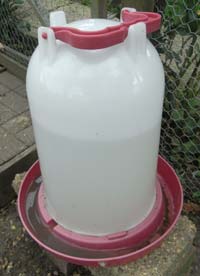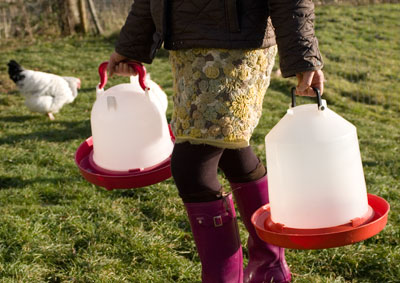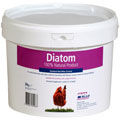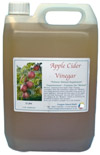Many people don’t include information about water in their information about keeping chickens – because it is, well, just water isn’t it? Well, in fact there is much to be said about drinking water for chickens and it is absolutely essential for their well being.
Here are the main things you need to know about water:

Dirty Water or Bacteria Soup?
Water needs to be fresh: if you leave it in the container for a few days at a time, it will start to go stagnant and turn green.
Now I hear you say that chickens can drink out of a muddy puddle and it does them no harm? That water is usually fresh rain water and the mud will certainly not harm them – but water kept in plastic containers that has turned green should be thought of as “bacteria soup” because it’s full of bacteria that can harm them.
Green drinking water is a sure way to be asking for trouble with diseases and should be avoided.
Changing their water daily or every-other day is easy enough and if you rinse the container out, you can use a small washing up brush around the lip and inside to remove any build-up of anything nasty.
A chicken’s body is constantly challenged by bacteria that cause diseases in their environment. Their body will build up an immunity (known as acquired immunity), however giving them large doses of “bacteria soup” will risk them becoming ill so please change water daily or at least every other day!
When you change their water, watch them rush over and take a drink – they do appreciate clean drinking water!
 Water needs to be kept in the shade during very hot weather: Chickens can handle the cold very well, they fluff up their feathers to trap air which insulates their body, however they can’t handle the heat very well. Chickens can’t sweat, they can only pant to lose heat through the air they breathe out and drink water to cool themselves down. During very hot weather, it is best to place their (fresh!) water in a shaded position (and after reading about shelter for chickens under the ‘Getting Started’ menu, you will of course be providing them with adequate shade).
Water needs to be kept in the shade during very hot weather: Chickens can handle the cold very well, they fluff up their feathers to trap air which insulates their body, however they can’t handle the heat very well. Chickens can’t sweat, they can only pant to lose heat through the air they breathe out and drink water to cool themselves down. During very hot weather, it is best to place their (fresh!) water in a shaded position (and after reading about shelter for chickens under the ‘Getting Started’ menu, you will of course be providing them with adequate shade).
Water containers left in the sunlight can soon heat up the water inside to a high temperature which means chickens can’t lose as much heat by drinking so please, keep their water in the shade during hot weather and if you can, give them some fresh, cool water when it’s hot.
Water containers
Water containers for chickens come in a variety of shapes and sizes to suit your needs. Some are galvanised and will last a very long time but the majority are plastic.
Galvanised Containers:
- Last a life time, withstands Knocks
- Withstands frost
- Cannot be used to give Apple Cider Vinegar since the acid corrodes the galvanising
- Doesn’t show you how much is left in the container.
Plastic Containers:
- Can be used to give Apple Cider Vinegar in the water
- Shows you how much water is left
- Will only last a couple of years – bases crack, locking bits snap off or handles break, colours fade in the sun.
- Will crack if you drop or knock it when full.
There is a full range of water containers for sale on this page at Amazon.






I have recently converted my shed into a coop and have three chickens.
I am worried about how often I should clean the coop, how to clean it and what I should put in the shed for them hay or wood shavings? Someone has sed use hay and remove the whole lot each week. I have a large supply of shavings to use up.
Also, I am feeding them morning and evening and giving them fresh water at the same time, but have been feeling a bit sick with the smell!
I just need practical tips on cleaning the shed out please!!
I clean mine every week at this time of year (the hens spend longer inside in the winter), sometimes in the summer I will leave it 2 weeks and just add a sprinkle of fresh shavings if I am very busy or away for the weekend but it does depend on the size of coop and number of hens in the coop of course.
You shouldn’t use Hay – this can harbour mould spores that cause a respiratory problem called Aspergilliosis. Pine wood shavings are much better. They don’t compact like hay and pine is a natural disinfectant so it will stay fresher for longer. You can buy shavings in equine / pet shops in a big bale. Snowflake is a common brand sold.
Ensure there is good ventillation – open the door of the coop in the morning and smell. If you smell strong ammonia, you need better ventillation. This harms their respiratory system and will be a fast track to respiratory problems later on.
What are you feeding them if you feel sick? Layers pellets have little smell to them.
Am I ok to use water from my water butt or is this not classed as fresh?
Ummm well it really depends what the quality of the water is… but in general, if it isn’t green and looks reasonably fresh I wouldn’t worry about it. I have used water from a butt before and not had problems.
We got 4 hens last Saturday and they don’t seem to drink a lot of water could there be a problem I have put fresh water at least twice a day but it doesn’t seem to be going down very much can you help
It can take them a while to get used to a new water supply. They don’t get through too much in the winter either. They will drink far more in the summer to cool down.
You mentioned in the post that you could add apple cider vinegar to the water… why would you do this and at what ratio?
Also, our chickens are in a chicken tractor working the garden beds on which there is straw for mulch; but, in one of the responses above you mentioned that hay could cause respiratory problems and too rather use woodchips? How important is this?
I have a page on Apple Cider Vinegar here that explains its use and the quantity to use.
Straw is best for bedding. Hay can be a problem as it is often dusty but also can hold mould spores that cause something called aspergillosis.
You mentioned Apple Cider vinegar. Can you explain the purpose and how much?
Please see my page on Apple Cider Vinegar